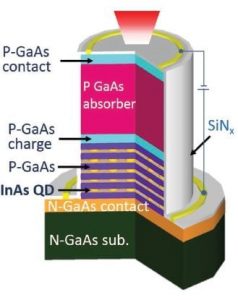Commercially available Si, InP/InGaAs and InP/InGaAsP avalanche photodiodes (APDs) operated in the 200–1700 nm wavelength range have been widely used in applications of optical communication networks, laser ranging and finding, gas distribution, defense, and imaging. By biasing at voltages above breakdown, APDs are capable of detecting light at single photon level, which have currently become an enabling technology driving development of many cutting-edge light detection applications, including three-dimensional laser detection and ranging (3D LIDAR), single photon counting, and diverse quantum communication protocols.
Performances of these application systems are currently limited by the APD’s photon detection efficiency which is essentially due to the bottleneck of the carrier avalanche probability in these conventional bulk multiplication materials. Exploration of novel multiplication structures that offer enhanced avalanche probability is highly desirable to break through this bottleneck.

Architecture of the reported quantum dot avalanche photodiode.
Recently, Yingjie Ma and colleagues from Shanghai Institute of Microsystem and Information Technology, University of California, and Shanghai Institute of Technical Physics, reported in Advanced Optical Materials a multilayer stacked semiconductor quantum dot multiplication structure that offers both enhanced avalanche gain factors and extremely low gain noise.
In the presented device 5-layer, stacked InAs quantum dots with GaAs spacers were integrated into a separated absorption, charge, and multiplication GaAs homojunction APD as the multiplication structure. Up to six times higher gain factors in comparison to a reference device and extremely low excess noise in close proximity to that of silicon are achieved under a strong electric field.
By comparison with other state-of-the-art enhanced APDs, the presented quantum dot multiplication structure attains the highest maximum gain factor and a superior gain noise performance. As concept demonstration, the reported results open opportunities for exploring performance enhancement of conventional APDs in other material systems using confined nanostructures.

















